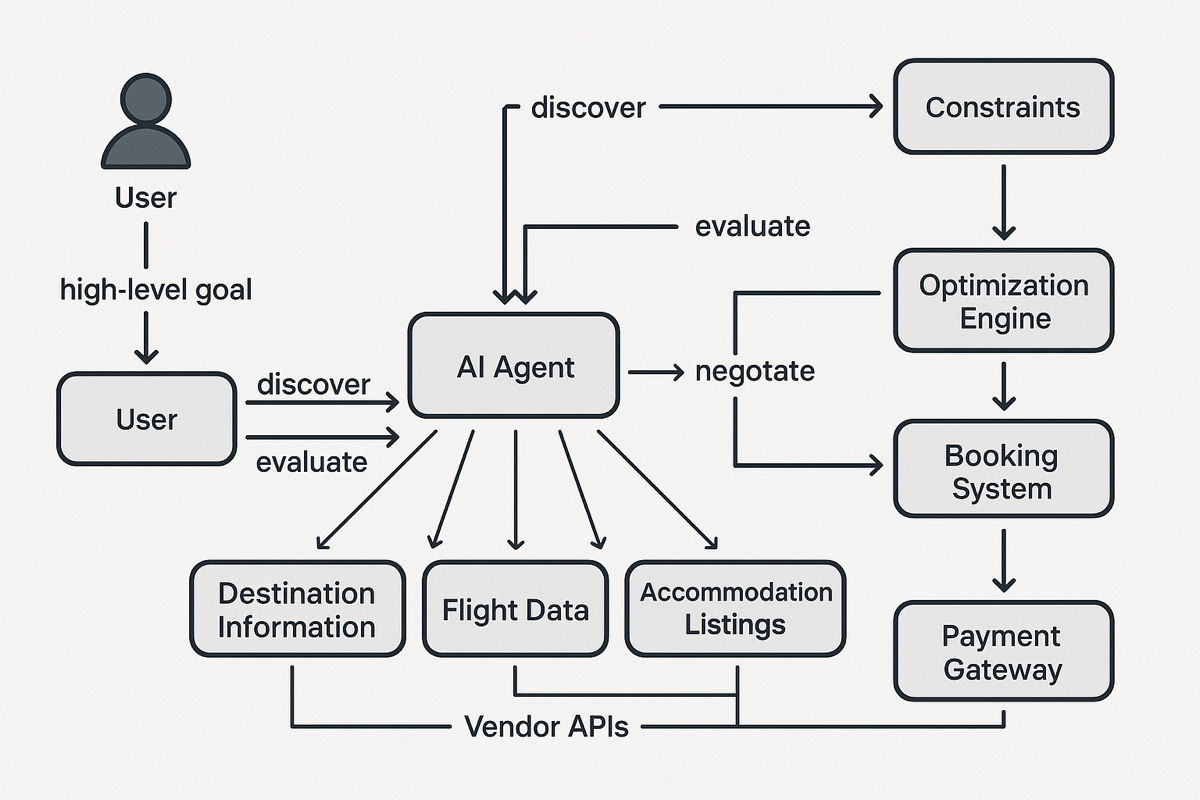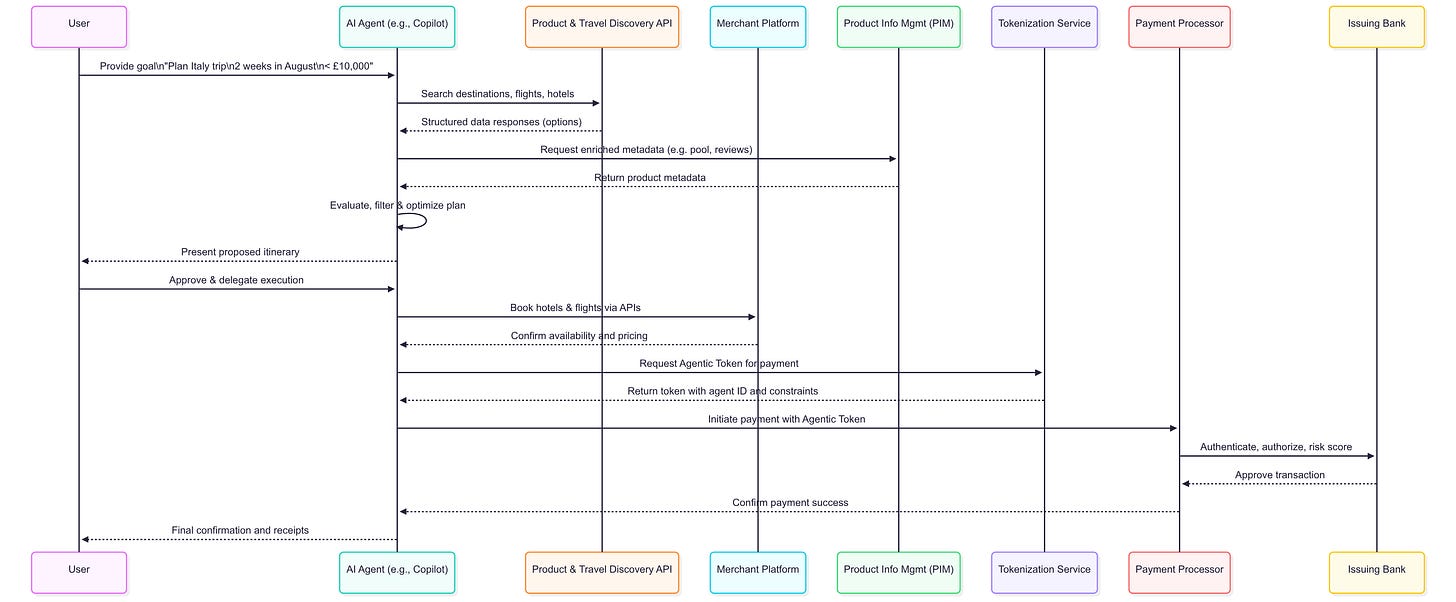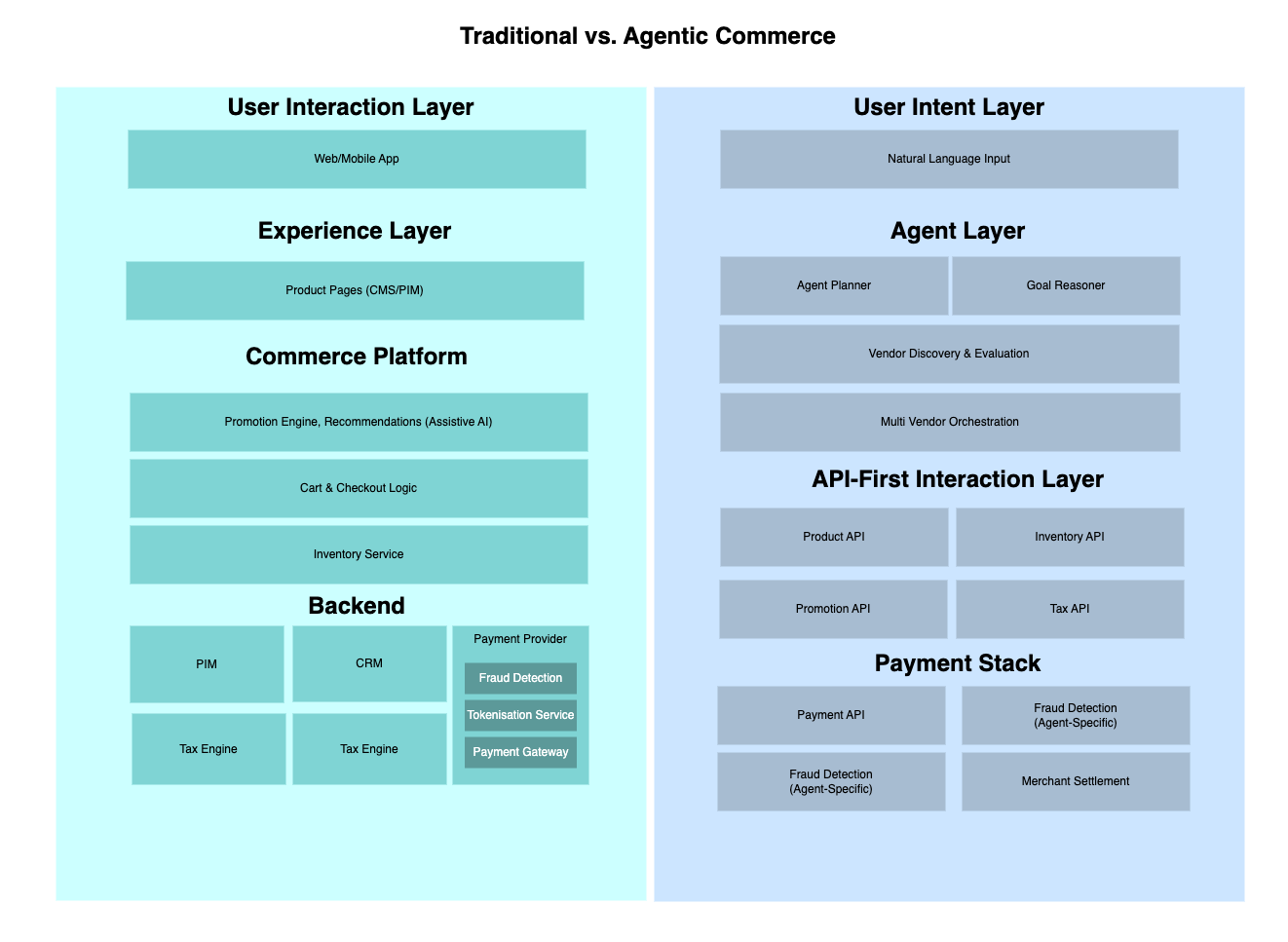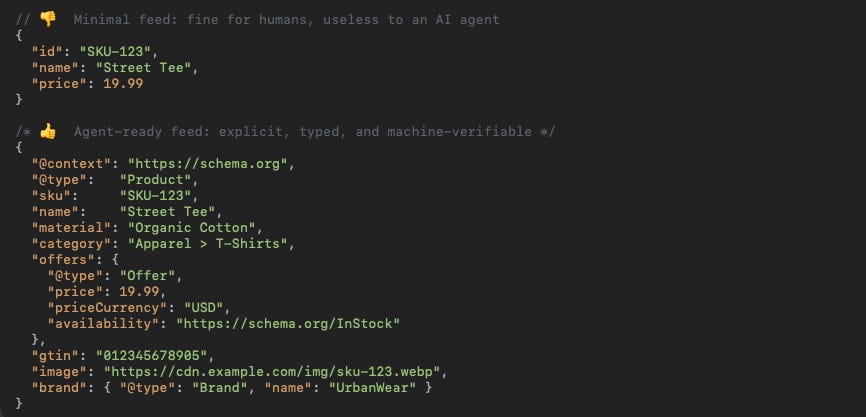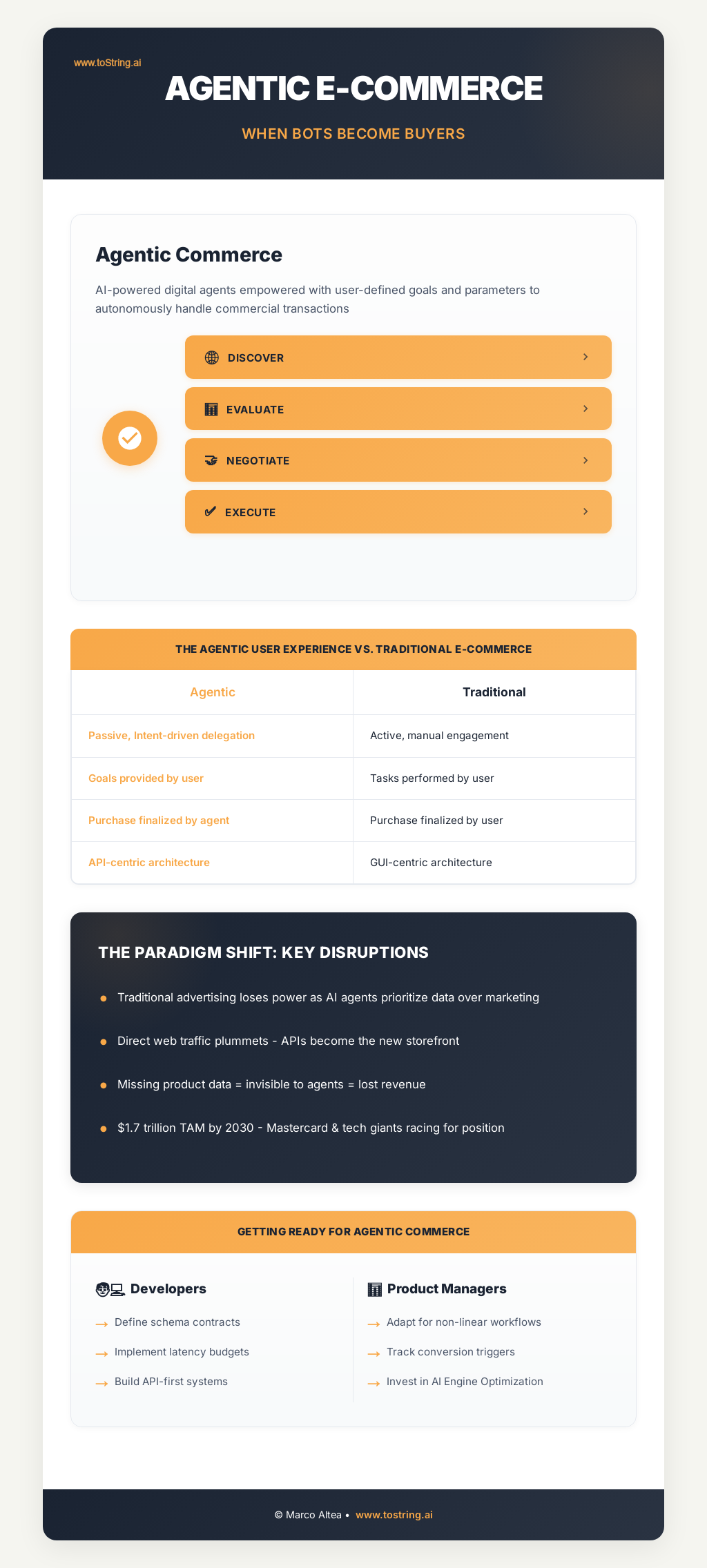Agentic E-commerce
When Bots Become Buyers
toString() delivers no-fluff, deep dives on practical AI & software engineering—hit “Subscribe” to get each new post in your inbox.
If you architect APIs or own conversion KPIs, keep reading.
I’ve spent the last decade designing, migrating, and extending commerce stacks—B2C fashion, B2B manufacturing, even a life-science site that sells antibodies. After ten years of checkout funnels and catalog feeds, one question keeps coming back:
What happens when the “shopper” is an AI agent that buys before the hero banner even loads?
That shift rewrites data contracts, payment rails, and the very metrics we use to judge success. Welcome to agentic commerce—let’s unpack what it means for both the stack and the roadmap.
`
There is no doubt that the landscape is undergoing a fundamental transformation, moving beyond incremental improvements to embrace a new paradigm powered by artificial intelligence. E-commerce was an early playground for assistive AI—recommendation engines and promo optimizers, but we’re now crossing into agentic AI, which is empowered to execute complex actions autonomously on behalf of a user. For years, AI has served as a helpful co-pilot in e-commerce, suggesting products and personalizing feeds. The emerging era of agentic commerce, however, sees AI transitioning from an assistant to an agent, a digital proxy with delegated authority to not only suggest but also to discover, negotiate, and complete commercial transactions with minimal human intervention. That step from assistance to execution is the core of the model, and it change the relationship between consumers, merchants, and the digital marketplace.
I was reading about the latest announcement from this Mastercard piece, and it’s clear that they want to shift from just payment processor to the provider of the infrastructure that enable machine-to-merchant interactions. As AI agents begin to handle a significant share of commercial activity, the infrastructure that verifies identity, secures payment credentials, and ensures transactional integrity will become more critical than ever. The success of this new paradigm is not only on the intelligence of the AI agents, but on the trust that consumers, merchants, and banks place in the rails that connect them.
So how will the e-commerce experience change?
Let’s start from definition, what Agentic Commerce means?
Agentic Commerce is the evolution of e-commerce where AI-powered digital agents are empowered with user-defined goals and parameters to autonomously
discover
evaluate
negotiate
execute
commercial transactions. It’s not only simple automation, such as recurring subscriptions or one-click checkouts. Instead, it involves the delegation (this is the keyword) of complex, multi-step decision-making processes from the human to the machine. For example, a user might instruct an agent with a high-level goal like, "Plan my family's vacation to Italy for the first two weeks of August, staying under a £10,000 budget, prioritizing non-stop flights and hotels with a pool". The agent would then be responsible for researching destinations, comparing flight and accommodation options across multiple vendors, optimizing for the given constraints, and, upon approval, executing all necessary bookings and payments
Architect lens: every arrow is a schema contract; break one and the agent aborts.
PM lens: conversion now happens after just two user intents—ask and confirm—so latency & data quality directly touch revenue.
The Agentic User Experience vs. Traditional E-commerce
So what actually changes?
Traditional e-commerce is defined by active, manual, and largely linear processes. The user is the primary actor, responsible for manually navigating websites, using search bars, comparing product specifications, reading reviews, adding items to a cart, and completing a checkout form. In contrast, the agentic commerce experience is characterized by passive, intent-driven delegation.
The user's primary role shifts from actor to director, defining a high-level goal or intent and delegating the complex execution to the AI agent. The AI becomes the primary actor, interacting with multiple vendor systems to fulfil the user's request.
This fundamental difference in user experience and operational flow is detailed in the comparative table below.
This framework highlights a critical operational pivot for businesses. For product managers and user experience designers, the focus must expand from optimizing graphical user interfaces (GUIs) for human interaction to optimizing APIs for machine interaction. For marketing strategists, the diminishing role of direct web traffic signals the urgent need to master new forms of discovery, such as
"AI Engine Optimization" (AEO), to ensure their products are visible and favored by these new digital gatekeepers
The Prerequisite: The Primacy of Structured Data
Missing fields == invisible to agents; see my Data-Debt teardown for the cost maths, as I discussed there, it will be paramount for any organisation that want to shift to this paradigm to have a strong data foundation, the successful implementation of agentic commerce is behind of a critical, often overlooked, prerequisite: the quality and accessibility of structured data (e.g. product data). AI agents do not "browse" visually appealing websites or get persuaded by clever marketing copy in the same way humans do; they parse vast amounts of structured, machine-readable data delivered via APIs to make analytical decisions. This reality imposes a new and urgent mandate on merchants: they must evolve their digital strategy from traditional Search Engine Optimization (SEO), designed to attract human eyeballs, to creating agent-friendly data ecosystems.
This involves significant investment in rich, detailed product feeds, real-time inventory APIs, and comprehensive metadata for all assets, including images and videos. For example, your product feed has to evolve from a human-friendly stub to an agent-ready payload that’s typed, verifiable, and rich enough for a bot to compare, negotiate, and buy:
This level of detail allows an agent to understand not just what a product is, but its attributes, context, and suitability for a user's specific request. Poor data quality, which already costs businesses millions annually, will transition from being a costly inefficiency to an existential threat in an agentic world. AI agents, programmed for efficiency, will simply bypass merchants whose data is incomplete, inaccurate, or inaccessible, rendering them invisible in this new marketplace.
KPI takeaway: Track the % of catalog that meets this “agent-ready” schema—every point of coverage expands your visibility in an AI-first marketplace.
Long-Term Disruptions and Second-Order Effects
As agentic commerce matures, its impact will extend far beyond the checkout process, potentially causing significant disruption to adjacent industries and creating new economic models.
Disruption of Digital Advertising: The current digital advertising model, particularly for search and social media, is predicated on capturing human attention and influencing human decision-making. If a significant portion of purchasing decisions are delegated to AI agents that prioritize objective, data-driven criteria like price, quality, and logistics, the effectiveness of traditional advertising could be severely diminished. Brands may need to shift their marketing spend from buying ads to enriching their product data and optimizing their API performance to appeal to these new algorithmic gatekeepers.
The "Zero-Click" Economy: For routine and replenishable goods—such as groceries, household supplies, or industrial components—commerce could evolve into a "zero-click" experience. In this model, AI agents, connected to smart devices (e.g., a smart refrigerator) or inventory management systems, would use predictive analytics to anticipate needs and autonomously reorder items without any direct human intervention.
Massive Market Potential: The financial stakes of this transformation are enormous. Projections indicate that the total addressable market (TAM) for agentic commerce could reach $1.7 trillion by 2030, highlighting why payment networks, tech giants, and investors are pouring resources into securing a foothold in this emerging market.
Does all of this mean emotional, instinct-driven purchases are dead?
The shift does not mean people will abandon the pleasure of an instinct buy; instead, emotional-led retail I believe will be re-engineered around hybrid “phygital” experiences.
Major brands are already turning stores into immersive showrooms where AR mirrors, AI kiosks, and mixed-reality fittings overlay digital content on physical garments, luring customers back to high-street destinations that many analysts now see rebounding rather than vanishing. At the same time, curated co-shopping services such as Harper Concierge for example which dispatch a stylist to a shopper’s home with a pre-selected rail of items, no payment up-front—are scaling the “try-before-you-buy” model that blends online convenience with human advice and tactile experience. I would not be surprise to see an agent that based on my taste, on the season, on the mood that I’m expressing in my digital interaction will take the initiative to choose a new jacket, t-shirt etc and send someone at home to let me try and potentially buy it. Another option enabled by virtual try-on that has an accuracy that keeps improving, will let agents pre-filter size and fit so that what arrives at the door (or awaits in the fitting room) is far more likely to delight, cutting costly returns for retailers. In short, the agent handles the admin—inventory checks, payment tokens, delivery orchestration—while the consumer stays in control of the expressive, sensory part of the journey. Retail, therefore, doesn’t split into “all-agent” vs “all-human”; it converges on a hybrid model where automation erases friction and high-touch environments
Lessons You Can Steal & Infographic💡
For Architects
Schema-first mindset Design product & pricing APIs as if the consumer is a bot, not only a browser.
Contract > pixel Version JSON schemas and publish them; break a contract and the agent churns.
Latency budgets Any saving in latency will increase AI Agent ranking
Simulate vendors use stubs and contract tests, so agent flows run before credentials arrive.
For Product Managers
Agent-ready catalog KPI Track “agent-ready catalog coverage” as a north-star metric
Schema quality = revenue Road-map items that raise schema quality have direct impact on sales.
Time-to-first-offer becomes as important as time-to-first-pixel.
Enjoy pragmatic takes on AI-driven commerce?


